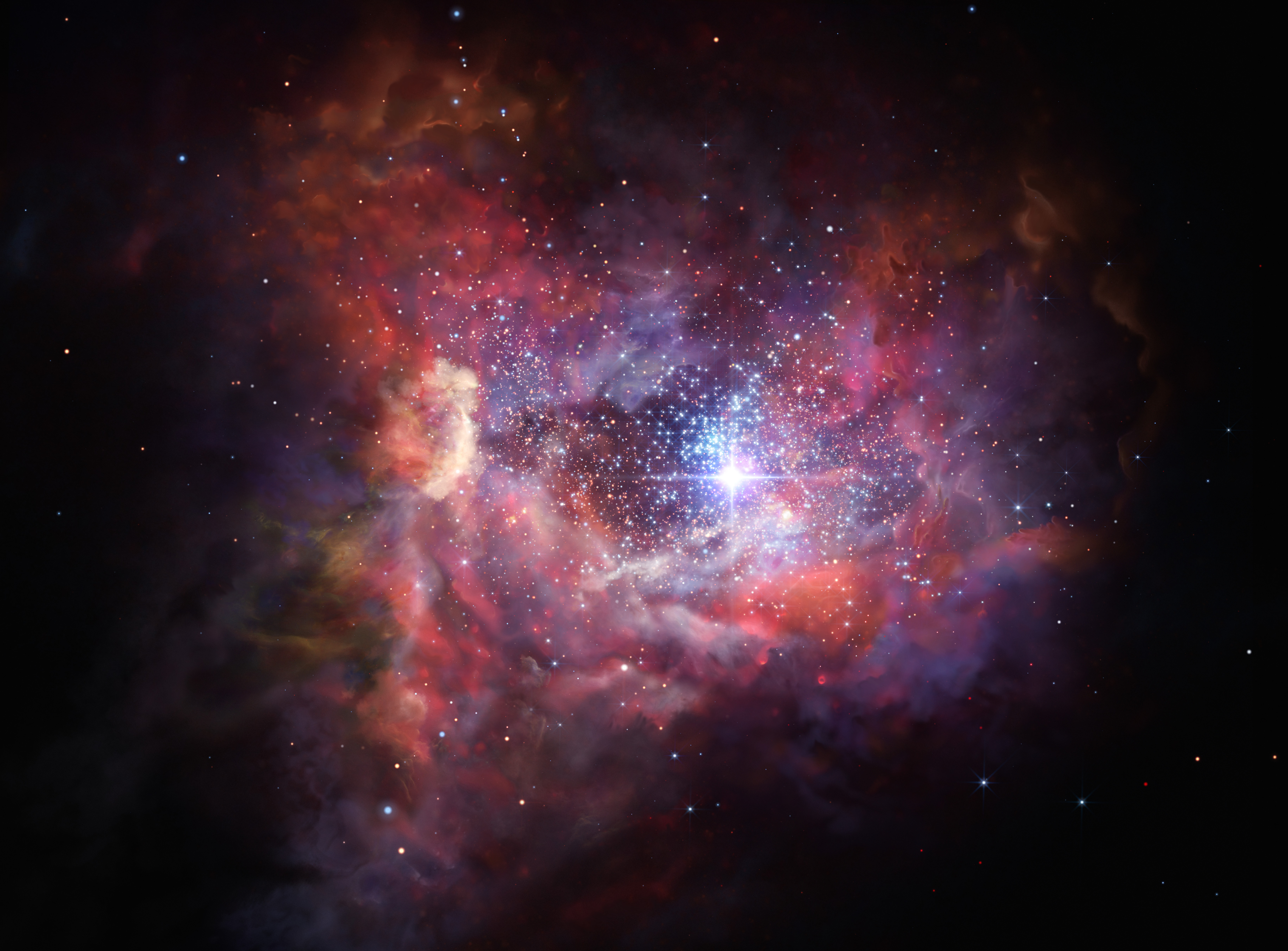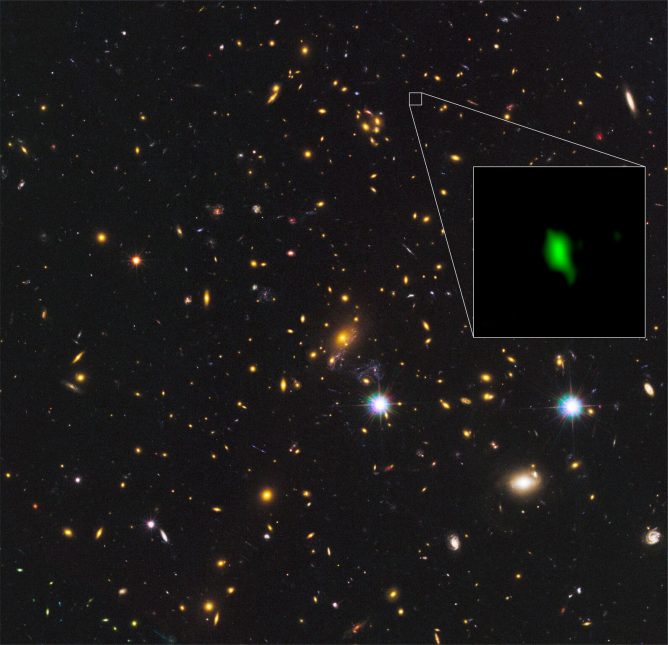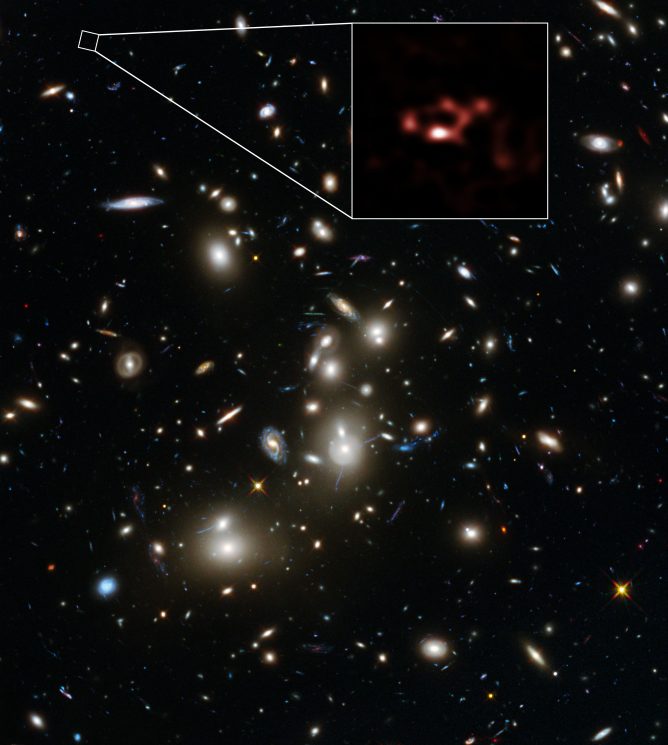2018.02.02
Universe Observed through Visual Acuity of 120,000/20 [vol.2] Searching First Galaxy in the Universe
This is one of the biggest mysteries that remain unsolved in modern astronomy. The ALMA telescope took on such a difficult challenge with unprecedented high sensitivity and resolution. How close can ALMA get to the beginning of the universe? What would the first galaxy look like?
Searching for the answer, we interviewed Dr. Yoshiaki Taniguchi, a professor at the Open University of Japan. He is a specialist of galaxy research who has dedicated himself to this field of study for many years. He explained the research about the galaxy formation using ALMA.
Beauty of Spiral Galaxy Sparked Interest in Becoming Astronomer
— Can you tell me about your encounter with a spiral galaxy that led you into the path to astronomy?
Taniguchi: In my childhood, I liked to catch and collect butterflies. Maybe it came from my longing for beautiful things. When I was a junior high school student, I found a picture of a spiral galaxy in an astronomy magazine that I borrowed from a classmate. It made me wonder how the universe can create such a beautiful thing. Then I got a small telescope from my parents and joined in an astronomy club at high school and started observing stars and galaxies with fellow club members. When entering Tohoku University, I decided to study galaxies further.
— What kind of galaxies are there in the universe, other than spiral galaxies?
Taniguchi: Spiral galaxies have spiral structures, as suggested by its name, like the famous Andromeda Galaxy. Although our Milky Way Galaxy also looks like a spiral galaxy, it actually is categorized as a barred spiral galaxy that has a bar-shaped structure in the galactic disk. Elliptical galaxies are another type of galaxies that have round and elliptical shapes with no spiral structure. They actually have a spheroid structure that is an approximately ellipsoid shape. There are other types of galaxies such as lenticular galaxies that have an intermediate shape between a spiral galaxy and elliptical galaxy, as well as irregular galaxies that have no regular shape. All of these galaxies are categorized by their shapes.

Upper left: Spiral galaxy Credit: NAOJ
Lower left: Barred spiral galaxy Credit: NASA, ESA, and The Hubble Heritage Team (STScI/AURA); Acknowledgment: P. Knezek (WIYN)
Right: Elliptical galaxy Credit: NASA, ESA, and the Hubble Heritage (STScI/AURA)-ESA/Hubble Collaboration; Acknowledgment: M. West (ESO, Chile)
— Among them, you were particularly fascinated by the beauty of spiral galaxies.
Taniguchi: Initially I was. But as I learned more about the galaxies, I started to feel a little bit differently. Spiral and barred spiral shapes are physically beautiful. But from the viewpoint of property analysis, there is no difference between these types of galaxies. One of the major galaxy properties is the component of a galaxy; for example, what kind of stars consist of a galaxy. In this sense, I started to think the difference of galaxies in terms of shape may not be so important for the “evolution” of galaxies, no matter being a spiral or barred spiral.
— You mean, physical beauty of a spiral galaxy turned out to be less interesting to you as a researcher.
Taniguchi: Right. My academic curiosity moved to the galaxies that have unique properties, such as a starburst galaxy where stars are being formed at an exceptionally high rate, and an active galactic nucleus (AGN) that has a supermassive black hole at the galactic center as a source of high luminosity. Then I started working on the research of starburst galaxies. Nowadays, the word “starburst” is familiar to most people, but it was quite a new term at the time. So I was sometimes feeling small while working on my research.
Dreaming to See the First Galaxy in the Universe
— You mentioned the “evolution” of a galaxy earlier. Could you explain it in more detail?
Taniguchi: In astronomy, “birth” and “evolution” are two key words in every field of research. In the field of galaxies, astronomers are aiming to find out how galaxies were formed in the history of the universe over 13.8 billion years. In other words, the goal is to solve the mystery of the birth of galaxies and furthermore the evolution process of galaxies, which has yet to be solved.
— The word “evolution” is familiar to us as a term of biology, but it is used in astronomy too.
Taniguchi: That’s right. For example, chemical composition of a galaxy constantly changes. At the time of the Big Bang, the universe was simply made of hydrogen and helium. Building blocks of our body such as carbon and iron are generated by fusion reaction inside stars and scattered around the space at their death, or generated by collision of neutron stars (which was in the news recently). And as a result, these materials are deposited in galactic gas. We astronomers are theoretically studying the birth and evolution of galaxies and investigating it by observations.
— When is it thought that the first galaxy was formed?
Taniguchi: It is thought that the first star was born in the universe when the universe was only 200 million years. Since the universe is now about 13.8 billion years, it dates back 13.6 billion years. As the first stars become the “seeds” of a galaxy, it is thought that the first galaxy was born around the same period of time. But this is only a theoretical thought because the first galaxy has not ever been observed in the universe.
— How can we see the birth of the first galaxy with a telescope?
Taniguchi: We need to see the farthest region of the universe. Since the speed of light has a limit (300,000 km/sec), seeing an object farther away means seeing an older picture of the object. In other words, by observing distant galaxies, we can study new-born galaxies at the early stage of the universe.
— A telescope is a time machine that makes it possible to go back in time and see the universe in the past.
Taniguchi: Indeed. Although no telescopes have yet to successfully observe the first galaxy in the universe, I believe ALMA can make it happen.
ALMA to Observe Dust and Gas in Distant Galaxies
— Subaru Telescope and the Hubble Space Telescope are also famous for their capability to observe distant galaxies. What is their difference from ALMA?
Taniguchi: Simply speaking, Subaru and Hubble observe light emitted from stars that compose a galaxy, while ALMA observes radio waves emitted from dust and gas contained in distant galaxies.
— ALMA observes radio emissions from dust and gas, instead of light from stars.
Taniguchi: Right. ALMA is capable of observing radio waves at millimeter and submillimeter wavelengths. In the universe, some galaxies emit radio waves intensely at submillimeter wavelengths in particular. This type of galaxies is called “submillimeter galaxy”.
— What is the characteristics of a submillimeter galaxy?
Taniguchi: An entire galaxy is surrounded by dense dust. Light cannot get out of the galaxy because light emitted from stars inside the galaxy is completely absorbed by dust. So, this type of galaxies cannot be observed by optical telescopes such as Subaru and Hubble telescopes. On the other hand, ALMA can capture submillimeter waves, which are emitted from dust heated by absorption of light.
— What is the reason for dust surrounding submillimeter galaxies?
Taniguchi: There are two possible reasons: One is due to starburst, which was mentioned earlier. Starburst is a phenomenon where massive stars (10 to 50 times the mass of the Sun) are formed at an explosive rate. A galaxy with more than ten thousand massive stars is categorized as a starburst galaxy, and some starburst galaxies have an astonishing number of massive stars like 100 million stars. A massive star has a short life and undergoes a supernova explosion after several millions to several tens of million years. With such explosion, materials made inside a star are scattered around and become ingredients of dust. As a consequence, the galaxy is immediately filled with dust, which covers light emitted from new stars formed in the galaxy.
— That’s why astronomers need to observe submillimeter emissions from dust.
Taniguchi: Technically speaking, heated dust emits far-infrared rays. It will be observed at submillimeter wavelengths as a result of a phenomenon called “redshift” where the wavelength of light is stretched due to the expansion of the universe.
— What is another reason for dust surrounding submillimeter galaxies?
Taniguchi: It is caused by active galactic nuclei (AGN) which is also mentioned earlier. It has already been proved that many galaxies, including our Milky Way galaxy, contain a supermassive black hole more than several millions times the mass of the Sun at the galactic center. A supermassive black hole is surrounded by gas, which emits light at high temperature when falling into a black hole, and its luminosity is observed as an AGN. AGNs emit strong ultraviolet radiation that also have a heating effect on dust around the nucleus. Here again, heated dust emits radiation at submillimeter wavelengths.
— Are there many submillimeter galaxies among distant galaxies at an early stage of formation?
Taniguchi: Yes. Newly formed galaxies evolve very rapidly through intense activities involving starburst and AGNs. Observing such an evolution process is ALMA’s specialty that is capable of observing at submillimeter wavelength.
Detecting Carbon and Oxygen Formed in Distant Galaxies
Taniguchi: Moreover, ALMA can not only capture millimeter and submillimeter waves emitted by heated dust in distant galaxies, but also millimeter and submillimeter waves specific to oxygen and carbon formed in galactic gas. Elements like oxygen and carbon did not exist just after the creation of the universe, because they are produced and spread out in a galaxy as a result of some cosmic events like a supernova explosion of a massive star. This means, we can understand how the galaxies evolved in an early phase of the universe by identifying the time and the rate of accumulation of oxygen and carbon in distant galaxies.

This image is dominated by a spectacular view of the rich galaxy cluster Abell 2744 from the NASA/ESA Hubble Space Telescope. But, far beyond this cluster, and seen when the Universe was only about 600 million years old, is a very faint galaxy called A2744_YD4. New observations of this galaxy with ALMA, shown in red, have demonstrated that it is rich in dust.
Credit: ALMA (ESO/NAOJ/NRAO), NASA, ESA, ESO and D. Coe (STScI)/J. Merten (Heidelberg/Bologna)
— To put it the other way around, if no oxygen or carbon is found in a distant galaxy, it is thought to be a newly formed galaxy.
Taniguchi: It is supposed that way. If oxygen and carbon is detected, it will be evidence showing that the target object is a galaxy a certain period of time after its birth or a chemically evolved galaxy. Detection of oxygen and carbon in distant galaxies will bring another advantage; it allows us to estimate the distance to the galaxy accurately. Carbon and oxygen have specific spectra at infrared wavelengths. We can measure the distance to the distant galaxy by studying how much the wavelengths are stretched before it reaches the Earth as submillimeter waves.
— Isn’t it possible to accurately measure the distance to a distant galaxy at this point?
Taniguchi: This might be a little bit technical, but we measure the distance to a galaxy using a specific light spectrum (ultraviolet) called “Lyman alpha line” emitted by hydrogen atom. However, observation tends to be difficult and the accuracy of measurement sometimes becomes not so reliable, because a substantial amount of hydrogen atoms around a distant galaxy absorbs Lyman alpha lines emitted from the galaxy. On the other hand, submillimeter waves emitted from oxygen and carbon formed inside distant galaxies are not susceptible to any absorption, which enables us to accurately measure the distance to a distant galaxy.
Can Giant HIMIKO be a Primordial Galaxy?
Taniguchi: Himiko is one of the most interesting distant objects observed with ALMA. Himiko is an enormous gas cloud 13 billion light years away, which dates to a time when the universe was 800 million years old. It was first discovered by Subaru Telescope in 2009. The size of the object spans about 55 thousand light years across, 10 times as large as normal-sized objects of the same period.
— Given that Himiko is supposed to have already existed when the universe was 800 million years old, Himiko could be an object that was formed much later than the birth of the first galaxy when the universe was 200 million years old. Is that right?
Taniguchi: Right. However, as a result of the ALMA observation of Himiko, no submillimeter emissions from dust or carbon were detected. It was something totally unexpected, because we all thought Himiko must contain dust and carbon.

Artist’s rendition of Himiko that is based on the results from the observations of ALMA and Hubble Space Telescope. Himiko is mainly composed of clean primordial gas with a little amount of heavy elements.
Credit: NAOJ
— So, does that mean Himiko is made of only hydrogen and helium gas?
Taniguchi: Right. Himiko could possibly be a forming “primordial galaxy” if it has no dust or carbon.
— But, it feels a little bit strange to consider Himiko as an unevolved galaxy even if it has no dust or carbon, in spite of the fact that Himiko had already existed when the universe was 800 million years old.
Taniguchi: I understand. But such possibility is also suggested by simulations. In the large-scale structure of the universe, the material is not evenly distributed. There are high-density regions as well as low-density regions. Galaxies weren’t born all together at the same time. It is believed that stars and galaxies were formed in high-density regions with hydrogen and helium in the early stage of the universe, while there are stars and galaxies that were formed much later in low-gas-density regions. “Primordial galaxies” are not necessarily the first galaxies in the whole universe. Primordial galaxies include all galaxies that were formed from hydrogen and helium and have no dust, carbon or oxygen.
— It took 800 million years before the first stars were born in low gas density regions. Is that where Himiko was being formed as a primordial galaxy?
Taniguchi: Yes. Since we haven’t seen any primordial galaxy so far, it will be a breakthrough discovery of the 21st century if Himiko turns out to be a primordial galaxy.
— Is there any way to prove it?
Taniguchi: NASA plans to launch the James Webb Space Telescope (JWST) as a successor to the Hubble Space Telescope (HST) in 2019. JWST may be able to prove it, if it can find any evidence showing that Himiko has only hydrogen and helium.
Note: A new paper was published in December 2017 after this interview, which says radio emissions of carbon was detected in Himiko by a new analysis of ALMA data. If this is true, Himiko will not be considered as a primordial galaxy.
ALMA Deep Survey Exploring the First Galaxy in the Universe
— In the future, is it possible that ALMA can find the first galaxy in the universe?
Taniguchi: It’s quite possible. Probably, ALMA is more likely to find it, rather than the Hubble or James Webb Space Telescope. To make it happen, we need to carry out deep survey (deep space exploration) and observe the farthest astronomical objects by monitoring a specified spot for a long time.
— Have you conducted many deep surveys with various telescopes?
Taniguchi: Yes. I was engaged in many deep survey projects such as the Infrared Space Observatory (ISO) launched by the European Space Agency (ESA), the radio telescope James Clerk Maxwell Telescope (JCMT) in Hawaii, and the Subaru Telescope. In the deep survey with JCMT, I was a member of the group that discovered the first submillimeter galaxy in the world. I still remember that exciting moment.
— Have deep surveys been carried out in ALMA too?
Taniguchi: ALMA deep survey has been led by Professor Kotaro Kohno at the University of Tokyo. When one or two submillimeter galaxies were found by JCMT, it was really big news. Now, ALMA deep survey is successfully finding a stream of submillimeter galaxies. We are very pleased with these results.
— What needs to be studied to find new-born galaxies?
Taniguchi: As explained earlier, ALMA is able to capture millimeter/submillimeter emissions from oxygen and carbon contained in galactic gas. So, new-born, very young galaxies might be found incidentally by ALMA deep surveys at millimeter/submillimeter wavelengths. According to calculations by my research colleague, ALMA observations may reveal galaxies 13.6 billion light years away
–It will be the first galaxy that existed in the universe 13.6 billion years ago.
Taniguchi: That’s right. There is a theoretical calculation result showing that carbon and oxygen can be formed in galaxies about 200 million years after the birth of the universe as a result of a supernova explosion of a new-born galaxy where stars are formed exponentially at a rate of several thousands to several tens of thousands.
— We expect ALMA will make a big discovery!
Taniguchi: Deep survey is very interesting because we don’t know what we will find. And what we find will be the first picture of the new universe for all human kind. I hope ALMA deep survey will discover a new frontier of the universe that has never been reached.





![Universe Observed through Visual Acuity of 120,000/20 [vol.1] Astronomers Stunned by HL Tauri](https://alma-telescope.jp/assets/uploads/2017/03/naoj_alma_hltau_141106_01-1-668x668.jpg)





